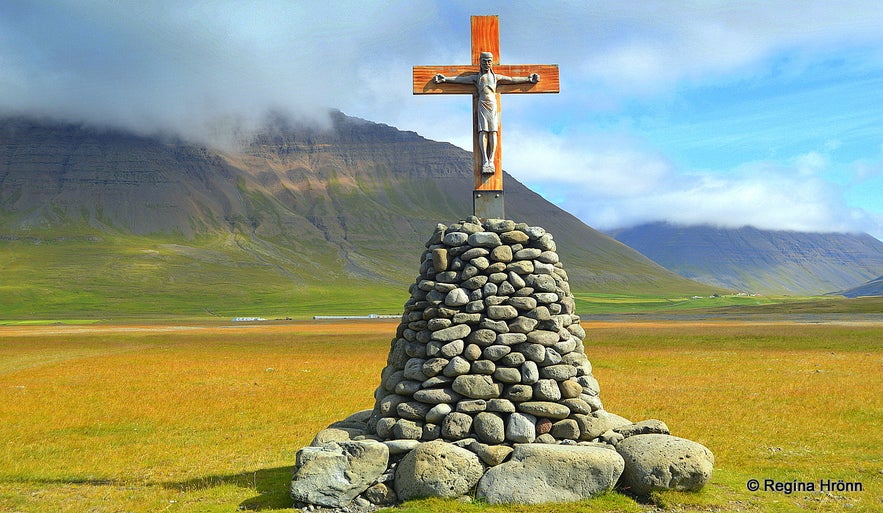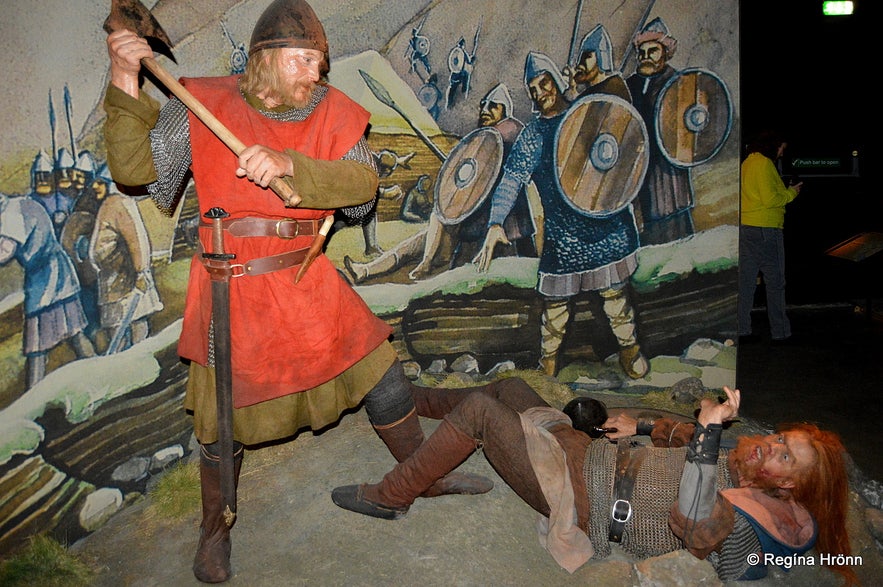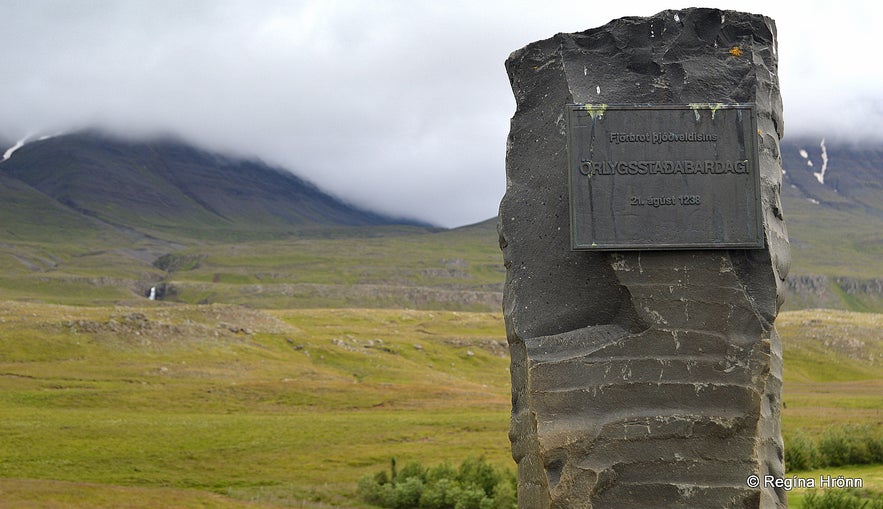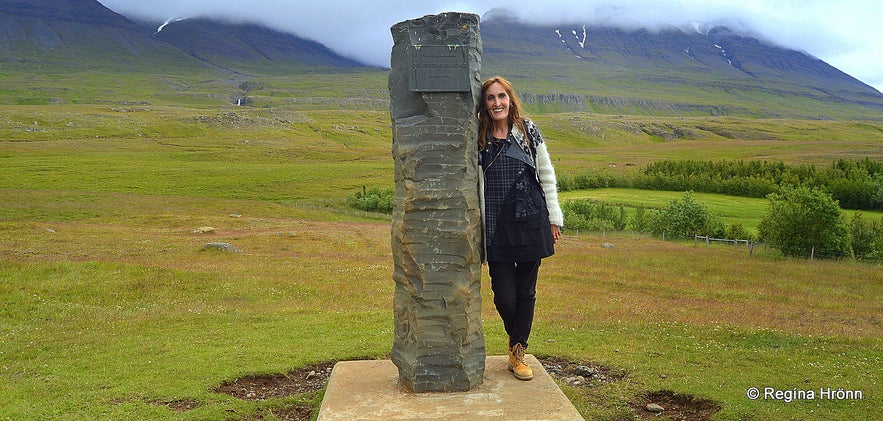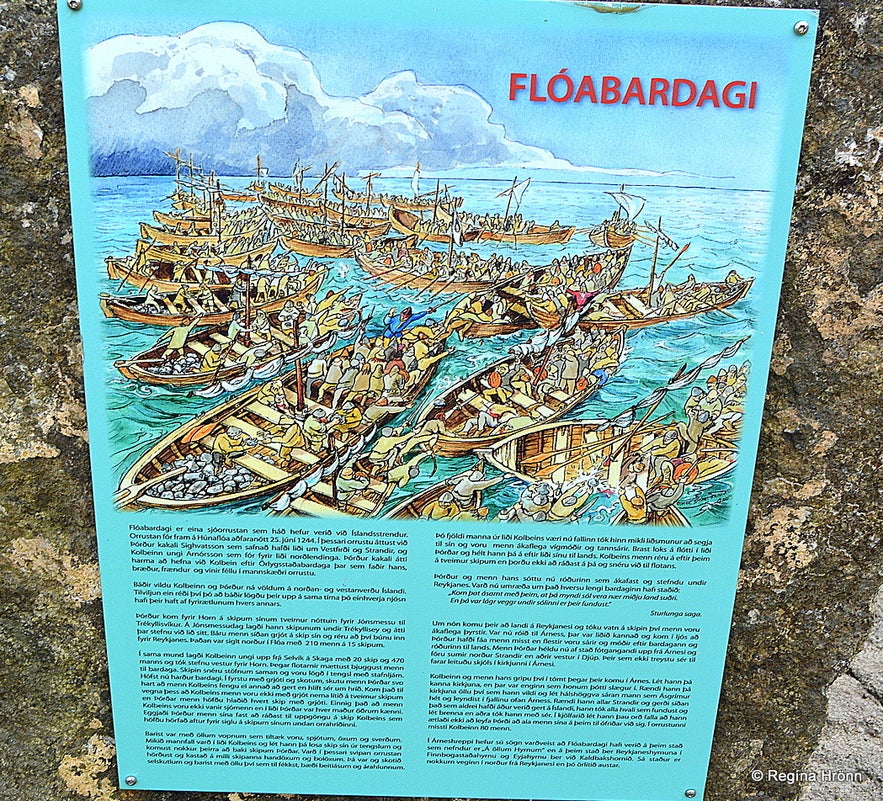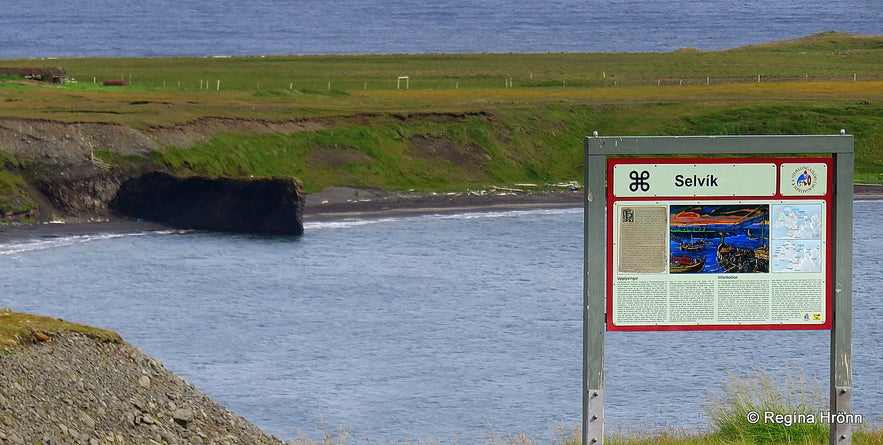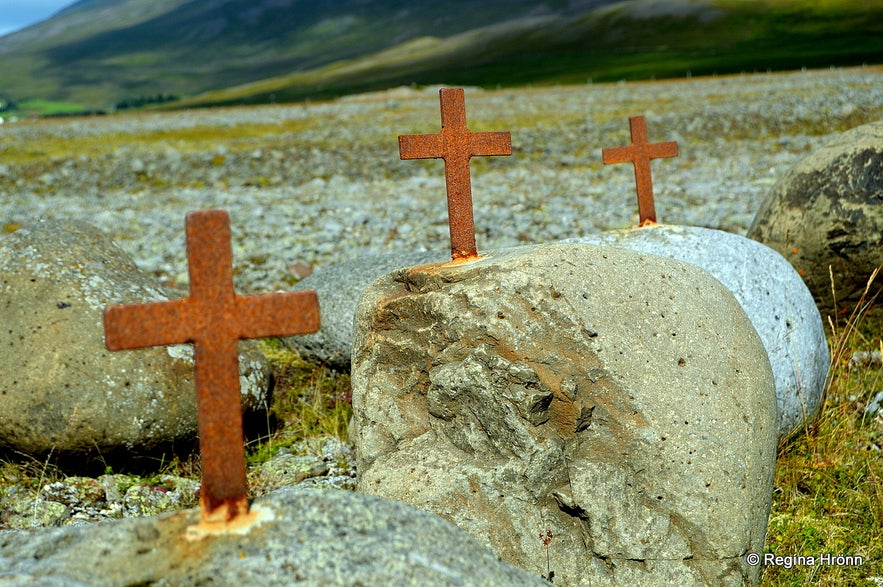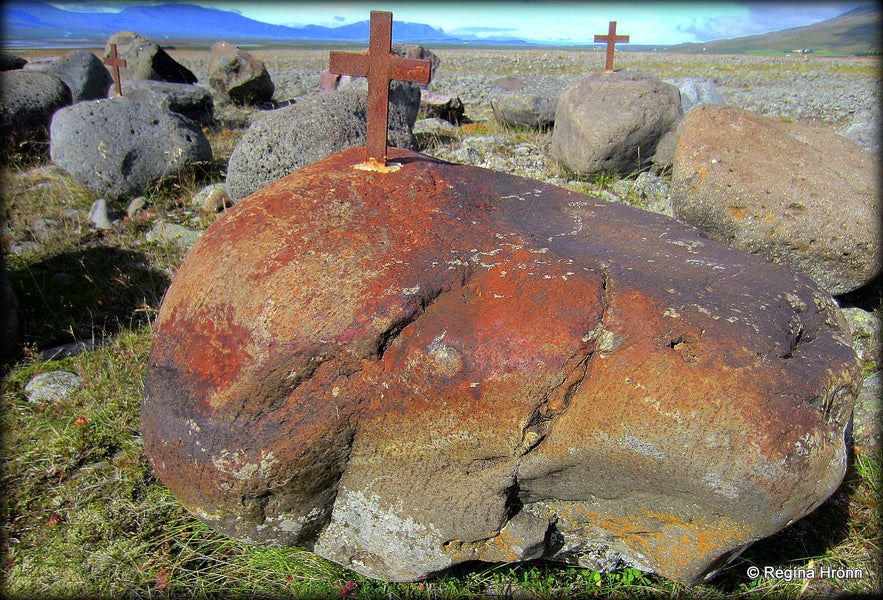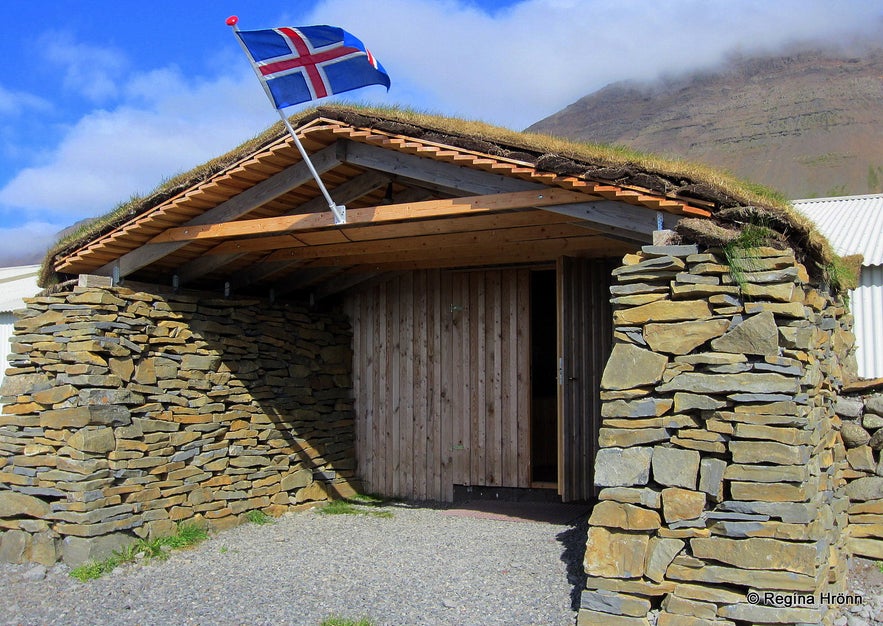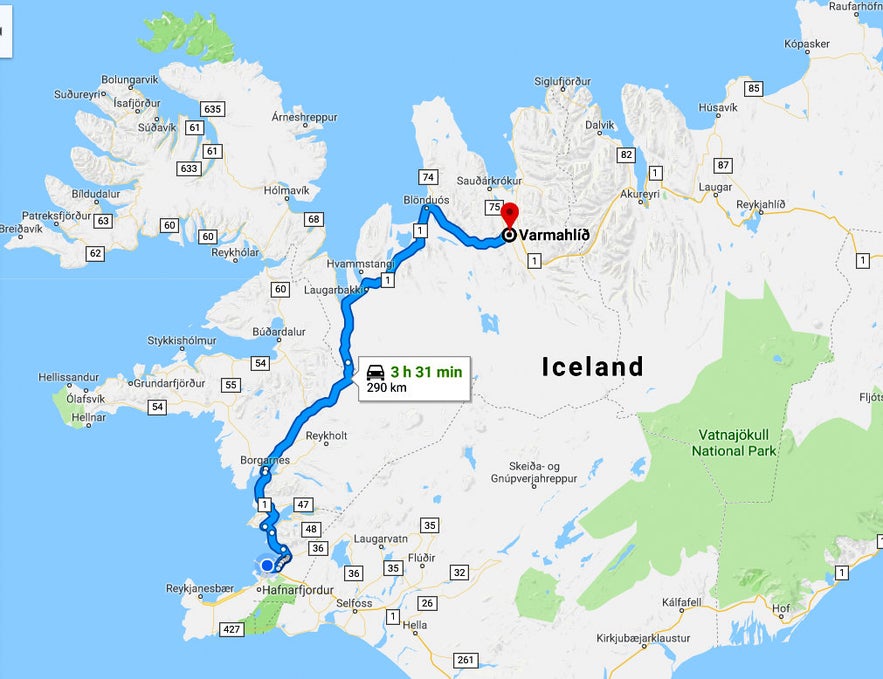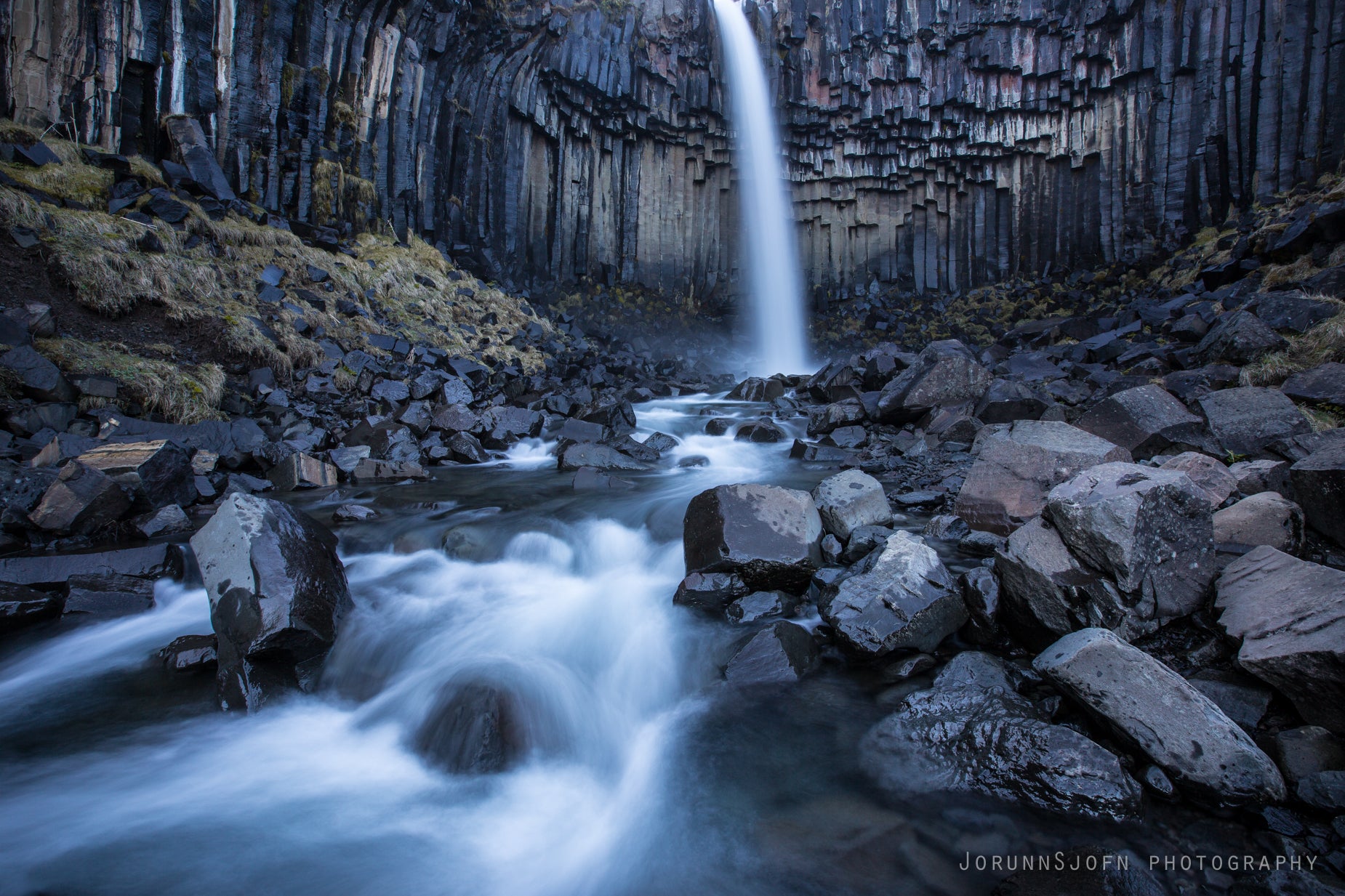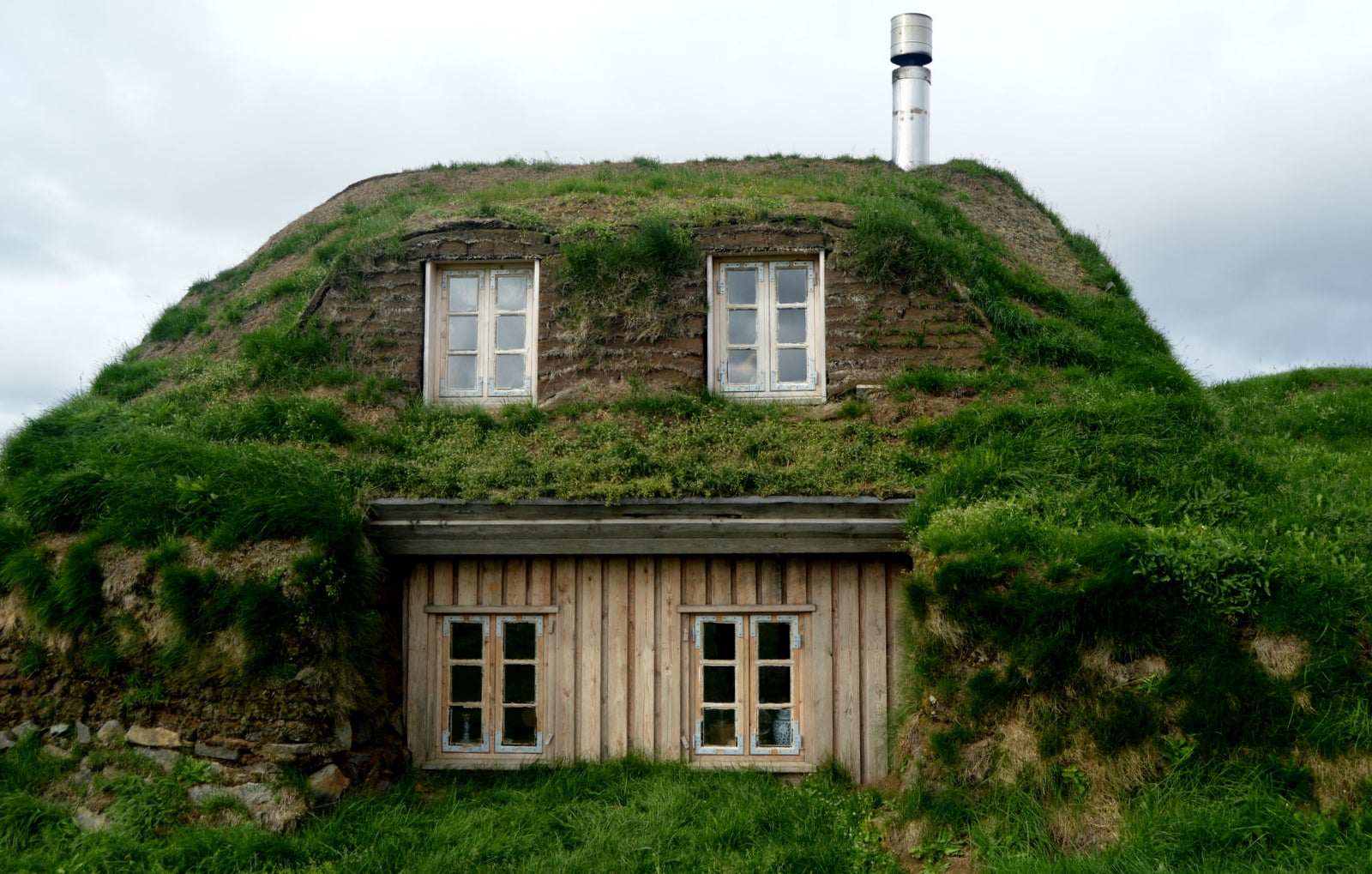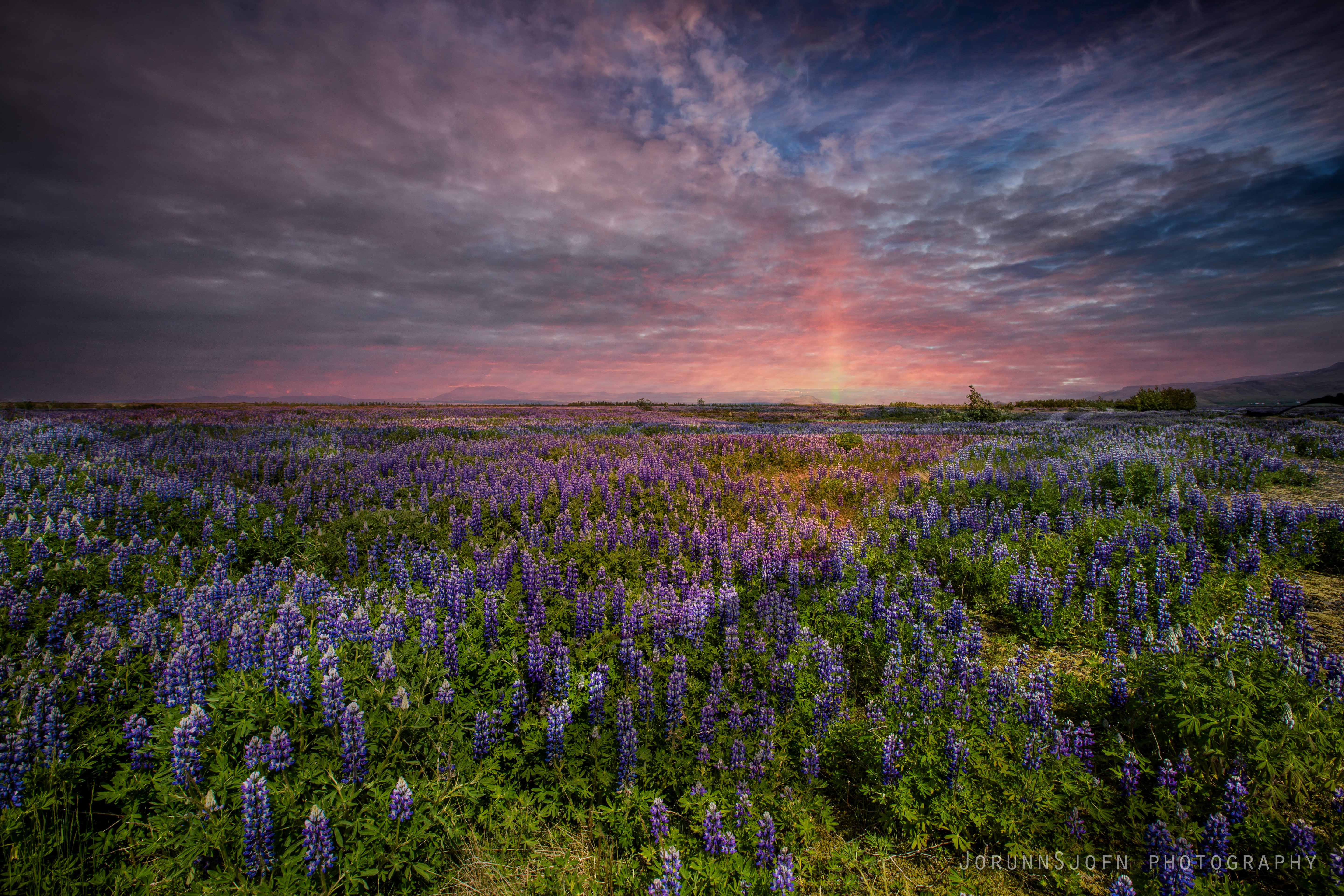In my last travel-blog, I told you about my ancestors, the Vikings, and Viking activities in Iceland today.
Now I want to show you some of the locations of the biggest Viking battles in Iceland. This is a travel-blog about my travels in Iceland to the better-known Viking areas in Sturlunga.
Top photo: the Holy Rood at Haugsnes
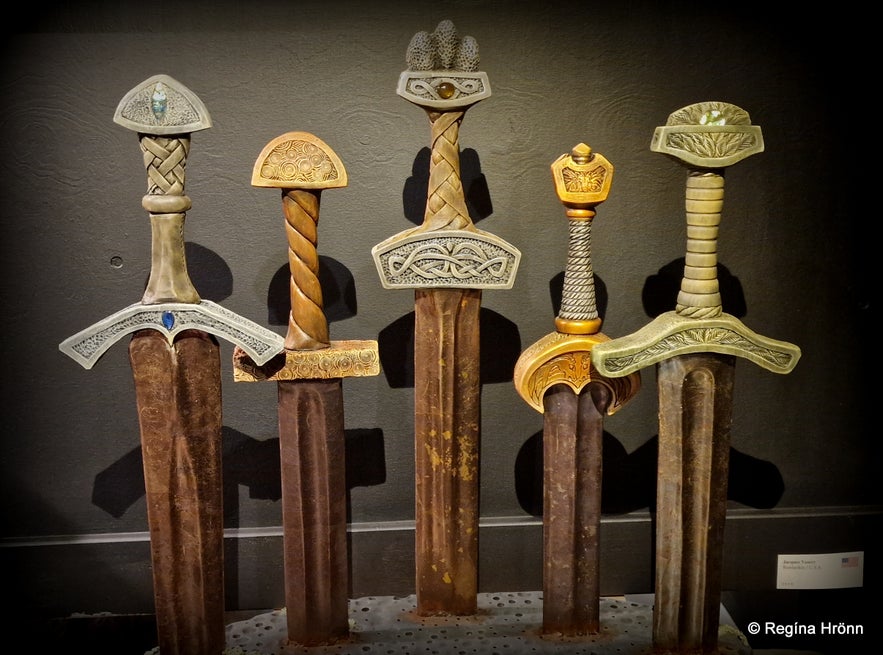 Viking swords - artwork at the Kakalaskáli exhibition which I recommend visiting
Viking swords - artwork at the Kakalaskáli exhibition which I recommend visiting
In Skagafjörður in North Iceland, you will quickly find yourself on the trail of the Vikings. Throughout history, several Viking battles were fought in this beautiful part of Iceland.
Remember the Clan of Sturlungar, which I have written about in other travel-blogs? Here they fought another clan, the Clan of Ásbirningar, who were known residents of this part of Iceland.
Two bloody Viking battles were fought in Skagafjörður; Örlygsstaðabardagi - the Battle at Örlygsstaðir and Haugsnesbardagi - the Battle of Haugsnes.
A third battle was fought at sea... Flóabardagi - the Battle of the Gulf.
Örlygsstaðabardagi | Iceland's Largest Viking Battle
Photo taken at the Saga Museum in Reykjavík - a crucial scene from Örlygsstaðabardagi battle
Örlygsstaðabardagi ("the Battle at Örlygsstaðir") took place on August 21st, 1238 at Örlygsstaðir, in Blönduhlíð, Skagafjörður.
Here the most powerful Viking clans in Iceland fought each other in what would become the largest Viking battle in Iceland's history—the Clan of Sturlungar against both the Clan of Ásbirningar and the Clan of Haukdælir.
Around 2,800 Vikings fought each other in this ill-fated battle, making it one of the bloodiest battles in this young country's history.
1,200 - 1,300 of them were from the Clan of Sturlungar whilst around 1,600 were from the Clan of Haukdælir and the Clan of Ásbirningar.
Photo taken at the Saga Museum - Sturla Sighvatsson killed in Örlygsstaðabardagi battle
The most important Vikings in Clan Sturlungar - the Chieftains - were Sighvatur Sturluson and his son, Sturla. The major Chieftains in the latter clans were Gissur Þorvaldsson and Kolbeinn ungi Arnórsson.
These were the most powerful Viking clans in Iceland, forever seeking more power in my country.
This would come to an end swiftly. The Clan of Sturlungar were taken by surprise in the early stages of the battle, and, after some ax-wielding violence, were quickly defeated.
Around 56 men lost their lives in this battle, 7 of them from the Clans of Ásbirningar and Haukdælar, and 49 from the Clan of Sturlungar. Among the dead were the chieftain Sighvatur Sturluson, from Grund in Eyjafjörður, and 4 of his sons.
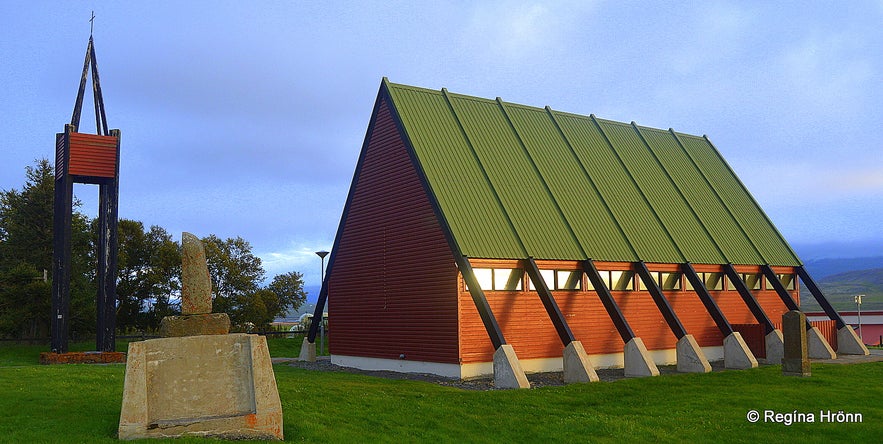 Miklabæjarkirkja church today
Miklabæjarkirkja church today
Atrocities took place here when some of the Sturlungar retreated and sought refuge in Miklabæjarkirkja church.
Two of Sighvatur's sons, who had sought refuge in the church, were taken and beheaded. Only one of his sons, Tumi, was able to escape.
Sturla Þórðarson was given pardon as his blood-brother was fighting in the opposite clan, but Sturla was a great contemporary story writer and wrote the Íslandingasaga part of the Sturlunga Saga.

Sighvatur Sturluson and his sons are believed to be buried at Munkaþverá in Eyjafjörður.
At the car park, you will find an information sign with an explanation of the Viking battle (see the photo below).
It is in Icelandic only, but "menn" means men or the clan. "Flóttinn" means the retreat of the men and "drepinn" means the killing of Sturla and Sighvatur.
A 10-15-minute walk leads you to a monument of Örlygsstaðabardagi. It is excellent that such a monument has been erected, although I personally, would have liked to see something more done at this location.
Still, wandering around the area, it wasn't hard to imagine what had taken place here.
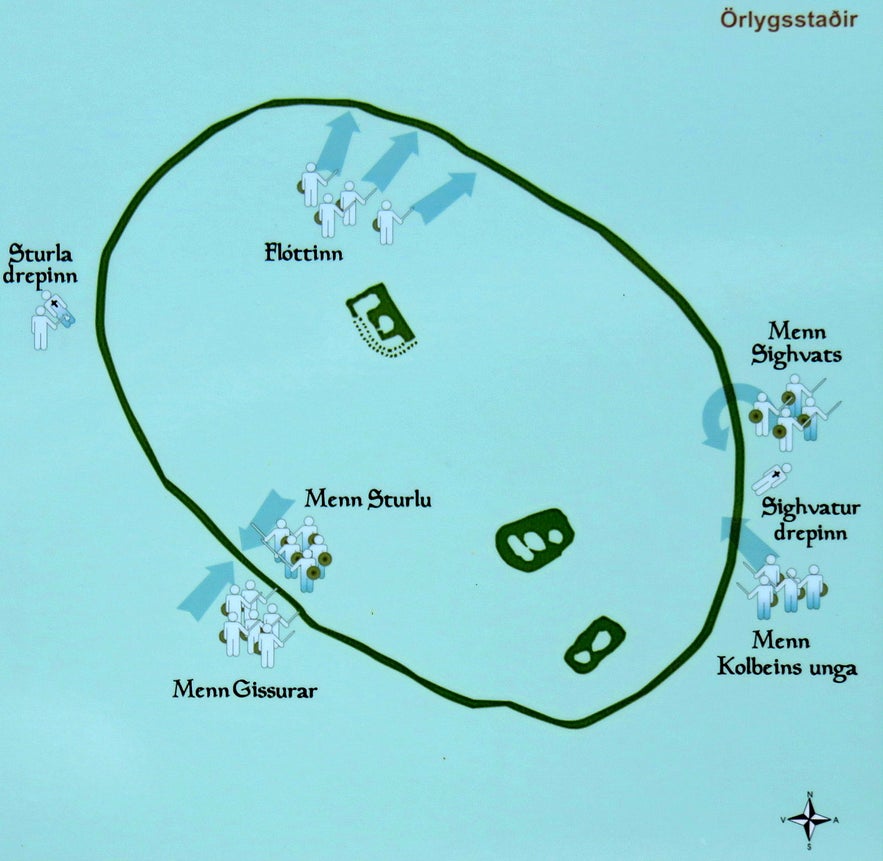
A statue of a Viking would do wonders in this area, though I know that such statues are too costly for a municipality to erect. So kudos to them for their work.
A steel plaque has been added with good information on the battle but, as fate would have it, some vandals have keyed the description, making it impossible to read...
It is a bit eerie standing on this spot, the spot where such a big Viking battle took place. If you are sensitive to energy, you will feel a lot of it coming from the ground of the battlefield here, just as I did.
The monument about Örlygsstaðabardagi
You can read about this battle in Sturlunga Saga, written by Sturla Þórðarson, who fought in this battle.
You can also visit the historical place Víðimýri in Skagafjörður, where the powerful chieftain of the Ásbirninga Clan, Kolbeinn Arnórsson ungi (1208–1245) lived.
There, you will also find a beautiful turf church. Sturlunga Saga tells us of a fortress at Víðimýri which Chieftain Snorri Sturluson erected back in 1220.
By the monument about Örlygsstaðabardagi
Gissur became one of the most powerful Chieftains in Iceland after the battle at Örlygsstaðabardagi, and 3 years later, he had Snorri Sturluson himself killed in his home at Reykholt.
Gissur had, earlier on, been married to Snorri's daughter. A terrible murder of a great man.
Do make an effort to visit Reykholt in West Iceland during your Iceland visit, as it is such a fascinating historical area. Reykholt is located on the Silver Circle in West Iceland.
My two photos of the Vikings at Örlygsstaðabardagi were taken at the Saga Museum in Reykjavík.
I highly recommend visiting this museum, where you can walk among life-size wax figures of the best-known Vikings and influential characters in Iceland's history.
The monument about Örlygsstaðabardagi
Directions: Örlygsstaðir is located in Skagafjörður, by ring-road 1, midway between Bóla and Miklabæjarkirkja church.
You can also drive to Sauðárkrókur town and visit the 1238 - the Battle of Iceland museum, where you can take part in a virtual Örlygsstaðabardagi battle.
1238 - the Battle of Iceland
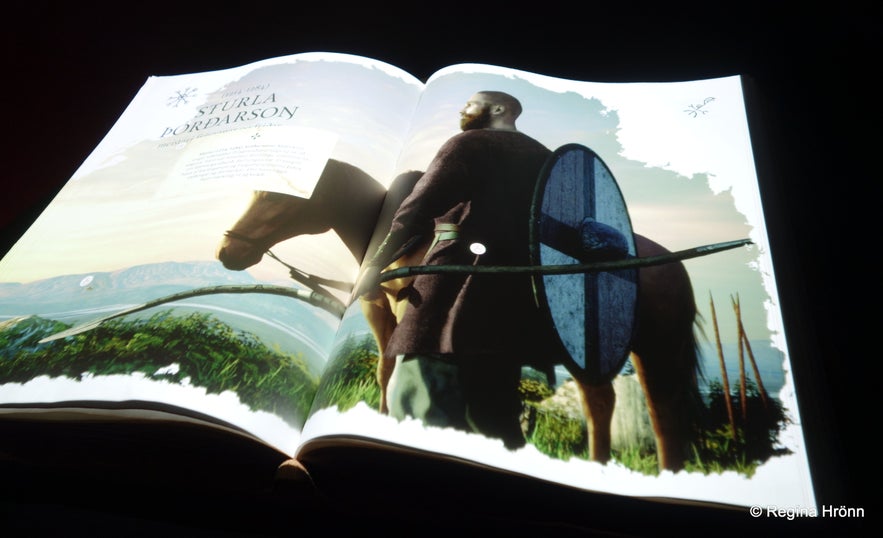
Sturla Þórðarson as depicted at the 1238 - the Battle of Iceland
I visited the 1238 - the Battle of Iceland exhibition in Sauðárkrókur village and highly recommend it, especially the virtual interactive part of the Örlygsstaðabardagi battle, where you can take part in the battle.
I have never wanted to take part in this horrible battle, and said no to partaking in it, but caved in under pressure. And I can tell you that his part of the museum is not to be missed, it was not fun but very interesting.
It is more fun for those who watch :)
 A map of Iceland that shows which areas each clan ruled over
A map of Iceland that shows which areas each clan ruled over
At the 1238 - Battle of Iceland, you will find various replicas of artifacts and weapons from this period, Sturlungaöld - the Age of the Sturlungs.
Here you will also find an interactive map of the locations where the battles took place. And a map of Iceland showing which areas each clan ruled over, which I found very useful.
 Replicas of women's clothing from this period
Replicas of women's clothing from this period
At the museum, you can also dress up in Viking clothes and have your photo taken. You can see mine at the end of this travel-blog :)
Flóabardagi | The Battle of the Gulf
Painting of Flóabardagi sea-battle, a part of a series of paintings by Jóhannes Geir Jónsson. I cropped it from the information sign at Skagi.
Another Viking battle of significance was Iceland's only sea battle, where both parties were Icelanders.
It didn't take place in Skagafjörður, but it is significant in the procedure of the Viking battles that took place here.
It took place in-between the Örlygsstaðabardagi and Haugsnesbardagi battles, on the 25th of June 1244.
The information sign at Trékyllisvík at Strandir in the Westfjords of Iceland
It is called Flóabardagi, the Battle of the Gulf, as it took place on Húnaflói bay. The battle was a direct consequence of the battles that preceded it, as we shall see.
On hearing the terrible news that his father and 4 of his brothers had been killed in Örlygsstaðabardagi, Þórður kakali Sighvatsson, of the Clan of Sturlungar, returned to Iceland from Norway, where he had been a courtier by the King's court.
Preparations for this Viking battle were made from Trékyllisvík at Strandir, and from Skagi. Sturlunga Saga tells us how Þórður kakali gathered men from the Strandir area and the Westfjords of Iceland.
The information sign at Selvík on Skagi peninsula
Þórður wanted to get power over his patrimony in Eyjafjörður, where Kolbeinn ungi of the Clan of Ásbirningar now ruled.
He prepared some 15 ships and around 210 men and set sail from Trékyllisvík.
Kolbeinn ungi Arnórsson and the Clan of Ásbirningar had gathered some 470 men, from Northern Iceland. Kolbeinn prepared his Viking ship fleet, consisting of 20 ships, from Selvík at Skagi.
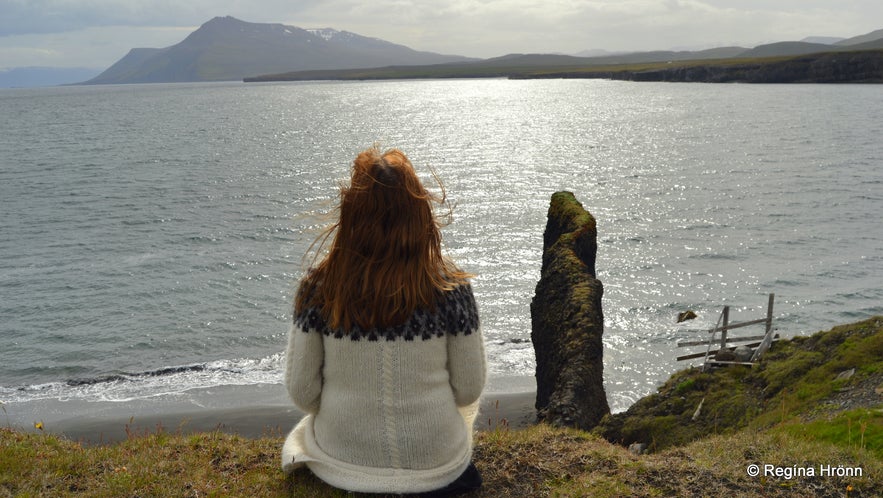 On the other side of Selvík pondering on what happened here back in 1244
On the other side of Selvík pondering on what happened here back in 1244
These first cousins, Þórður kakali and Kolbeinn ungi, met each other on Húnaflói bay.
Þórður kakali had filled his Viking ships with rocks and attacked the Clan of Ásbirningar by throwing rocks at them. Kolbeinn lost around 80 of his men, but Þórður lost only a few.
But, the advantage in numbers was still so great between these two powerful clans that Þórður kakali had to retreat 5 hours into the battle.
The Clan of Ásbirningar was exhausted after the battle and didn't chase after him. Kolbeinn pursued Þórður to Trékyllisvík and looted that area, which had dire consequences for this now remote and scarcely populated part of Iceland.
 Artwork at the Kakalaskáli exhibition
Artwork at the Kakalaskáli exhibition
Kolbeinn died of a chest illness a year later and before his death, handed Þórður kakali's patrimony over to him. Brandur Kolbeinsson took the reigns over the Clan of Ásbirningar in Skagafjörður.
Just imagine how closely related Þórður and Kolbeinn were - first cousins! It always startles me when I read the Sagas how closely related many of the fighting parties were, either by blood or by marriage.
The Battle of Haugsnes
The Battle of Haugsnes memorial stones
On the 19th of April 1246, the Clan of Ásbirningar lost to the Clan of Sturlungar in the bloodiest battle ever to be fought in Iceland.
The roles were reversed from Örlygsstaðabardagi, where the Clan of Ásbirningar defeated the Clan of Sturlungar.
Here, Þórður kakali Sighvatsson of the Clan of Sturlungar fought Brandur Kolbeinsson of the Clan of Ásbirningar.
 Artwork at the Kakalaskáli exhibition by Jón Adólf Steinarsson
Artwork at the Kakalaskáli exhibition by Jón Adólf Steinarsson
Þórður kakali Sighvatsson was the son of Sighvatur Sturluson, who was killed in Örlygsstaðabardagi with his 4 sons, so he had blood feud and was desperate for revenge.
The Clan of Sturlungar arrived with 600 men, but the Clan of Ásbirningar had some 720 men in their Viking army.
Around 111 Vikings lost their lives here, almost 40 from the Clan of Sturlungar and 60-70 from the Clan of Ásbirningar, among them Brandur Kolbeinsson.
By the Battle of Haugsnes memorial stones
Þórður had planted a spy in the opposite army and at a crucial moment in the battle, the spy pretended to flee.
This caused disruption in the Clan of Ásbirningar as others followed suit and retreated. Many were killed on the run.
Sturlunga Saga describes the battle as having been the most gruesome and bloodiest Viking battle in Iceland.
Again, the Vikings were fighting for more power in Iceland and, of course, there was revenge and blood feuds aplenty.
The Battle of Haugsnes memorial stones
Sigurður Hansen at Kringlumýri, has reconstructed the Viking battle in memory of all the lives lost in the battle.
Sigurður put up an army of more than 1,300 stones representing the combating armies. An iron cross on top of a stone represents a member of a fallen Viking.
Here in beautiful surroundings, you will be able to sit down and ponder on the meaningless nature of such battles and all the young (and old) lives lost, many of whom were from the same extended family.
The Holy Rood at Haugsnes in Skagafjörður
The large Holy Rood (róðukross) is a memorial for Brandur and the Clan of Ásbirningar. This place is called Róðugrund as, after the killing of Brandur, a rood was erected.
The current Holy Rood was erected in 2009 and made by the amazing artist Jón Adólf.
I applaud the idea of putting up a memorial and a stone army with so many crosses - to allow us, travellers, to find the place where such a big Viking battle took place - and to allow us to sit down and ponder on the meaningless of such a terrible battle.

Brandur Kolbeinsson, who got killed in this battle, lived at Reynistaður, which was one of the manors of the Clan of Ásbirningar.
At Reynistaður, you will find one gable of a turf house that belongs to Þjóðminjasafn Ísland - the National Museum of Iceland.
Later on, the Chieftain Gissur Þorvaldsson lived at Reynistaður when he held the title of Earl of Iceland, the only man to bear that title.

The information sign about Haugsnes
Above you will see the information sign by the car park at Haugsnes. In the middle of the sign, you will see one of the Viking paintings in a series by Jóhannes Geir Jónsson (1923-2007) who was born in Sauðárkrókur town, in Skagafjörður.
The car park is right by the farm, so let's be respectful of the working surroundings of the farmer. You can go through the gate and walk to the memorial. I visited this place a couple of years ago.
Kakalaskáli at Kringlumýri
But it is much better to take the path from the road leading to Kakalaskáli and check out the Stone Army from there.
I revisited this area recently and also had a look at the exhibition in Kakalaskáli.
The exhibition depicts beautiful works of art by 14 artists from 10 countries, showing us important events from the Sturlunga saga.
Kakalaskáli longhouse at Kringlumýri was built in 2011 and run by the abovementioned Sigurður Hansen and his wife María Guðmundsdóttir.
 We had a chat with Sigurður Hansen on our visit to the Viking exhibition at Kakalaskáli
We had a chat with Sigurður Hansen on our visit to the Viking exhibition at Kakalaskáli
Kakalaskáli was built in a former mink farm and outhouses and expanded.
I sat down with Sigurður Hansen in the Viking-style decorated café and had a chat with him about his excellent exhibition.
I found the video below on YouTube, showing Sigurður Hansen on the scene of Haugsnesbardagi's battle at Haugsnesstrandir.
In the video, Sigurður tells us the story of the Haugsnesbardagi battle - in Icelandic.
Sigurður has placed 111 iron crosses on the stones; 70 crosses on the stones representing the army of Ásbirningar and 41 crosses on the stones representing Þórður kakali's army, but that is the number of fallen Vikings he believes is closest to the truth.
Do visit him and check out the exhibition at Kakalaskáli. You can find more information on the website of Kakalaskáli.
The horrific act at Flugumýri in Skagafjörður
Flugumýri in Skagafjörður - Flugumýrarkirkja church
There is also pure Viking history at Flugumýri, in Skagafjörður. In the Age of the Sturlungs, Flugumýri was one of the manors of the Clan of Ásbirningar and here Kolbeinn ungi once lived.
Flugumýri is best known to us Icelanders for Flugumýrarbrenna, the Fire at Flugumýri in 1253, which is considered to be the worst single act of barbarism of the Age of the Sturlungs.
Gissur Þorvaldsson, who was of the Clan of Haukdælir, and an enemy of the Clan of Sturlungar, bought Flugumýri in 1253 from the church.
Photo taken at an exhibition on the Viking battles - Flugumýrarbrenna
He wanted to make peace with the Clan of Sturlungar and married off his eldest son, Hallur, to Ingibjörg the daughter of Sturla Þórðarson, who was of the Clan of the Sturlungar.
A big wedding was held and the wedding party lasted for 2 days. On the Tuesday after the wedding, the guests went home.
Not everybody from the Clan of Sturlungar was happy with this marriage and wanted Gissur Þorvaldsson dead. Eyjólfur ofsi Þorsteinsson was married to Þuríður, the daughter of Sturla Sighvatsson, whom Gissur had killed at Örlygsstaðabardagi.
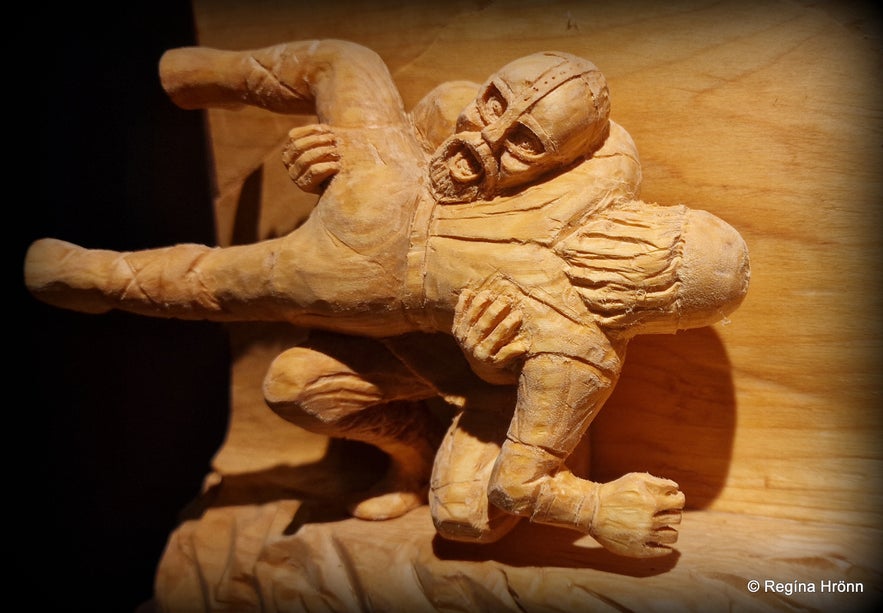 Artwork at Kakalaskáli
Artwork at Kakalaskáli
Þuríður wanted revenge for her father and brothers. Eyjólfur and his friend, Hrani, recruited a group of 42 armed men and arrived at Flugumýri after the wedding guests had left.
30 people lived at Flugumýri, not all of them able to hold a weapon. The ones who could put up a brave defense.
Seeing that the attacking men couldn't force their way into Flugumýri, they decided to burn down the manor.
Twenty-five people were burnt alive inside, among them the wife of Gissur and his 3 sons. The 13-year-old bride, Ingibjörg, got saved by her kinsman among the attackers, and Gissur saved himself by hiding in a barrel of sour acid.
Flugumýri in Skagafjörður - Flugumýrarkirkja church
The 16-year-old bridegroom, Hallur Gissurarson, jumped out of the burning farm, but his enemies hit him on the head and almost cut off his leg :(
He survived and the monk Þórólfur dragged him on a lambskin to church, where he died the next morning.
His father, Gissur, was helped to the church after he got out of the barrel of sour acid. Gissur was the only survivor of his family - what a terrible ending to a wedding party.
This dreadful event took place on the 22nd of October 1253.
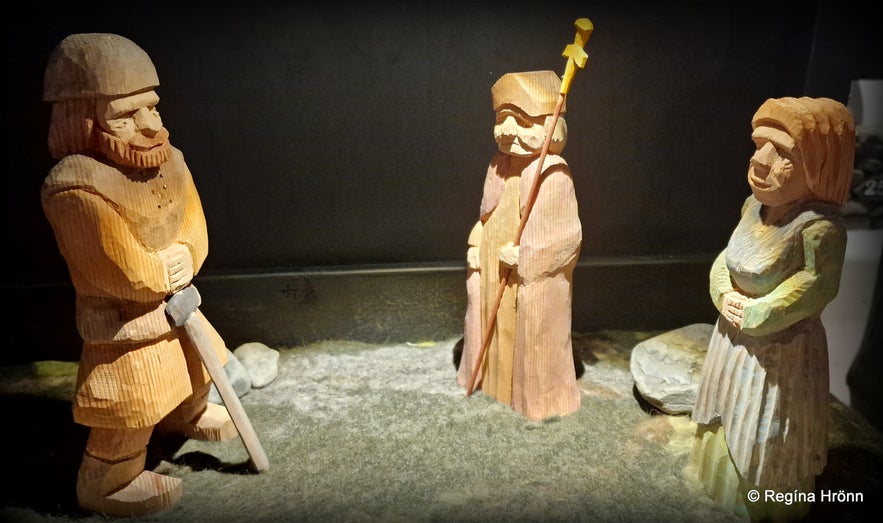 Artwork at Kakalaskáli
Artwork at Kakalaskáli
Flugumýri manor was the most stately manor in Skagafjörður and only Hólar bishopric was more stately. So apart from the loss of lives, there was a huge loss of property in the fire.
Flugumýri has always been considered one of the best lands in the fertile Skagafjörður. Here Þórir dúfunef settled and Fluga (fly) was the name of his speedy mare.
There is now a horse farm at Flugumýri.
Flugumýri information sign
There is not much to see here now apart from visiting the church, which was erected in 1930. If you visit the church you will see that there is a path leading to a hill.
On top of that hill, there is Virkishóll, remnants of an old fort from the Age of the Sturlungs. I have been meaning to hike up to it for ages, but never get around to it.
Directions: Flugumýri is just off ring road 1 on road 76.
In the historical Skagafjörður, you will also find the beautiful turf houses Glaumbær and Tyrfingsstaðir, plus a turf church, which has been called the most beautiful of all our turf churches, the turf church at Víðimýri.
See also my travel-blog:
Víðimýri turf church - is it the most beautiful of them all?
To reach this area it is best to rent a car and drive up to Skagafjörður in 3.5 hours.
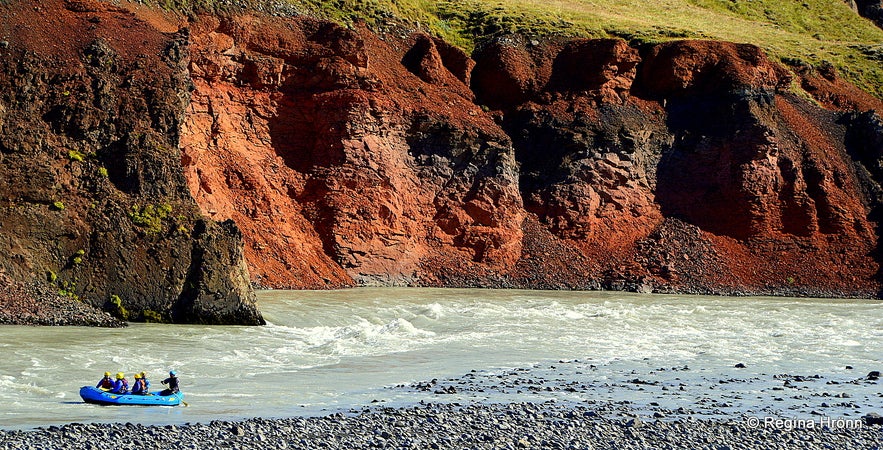
Watching people river rafting
While visiting Skagafjörður you can go river rafting on a roaring glacial river River Rafting Tour in North-Iceland | West Glacial River.
I do not have the guts to go river rafting, as instilled in me is a fear of the glacial rivers of Iceland, but it was fun watching them.
 Dressing up as Vikings at the 1238 - the Battle of Iceland exhibition
Dressing up as Vikings at the 1238 - the Battle of Iceland exhibition

